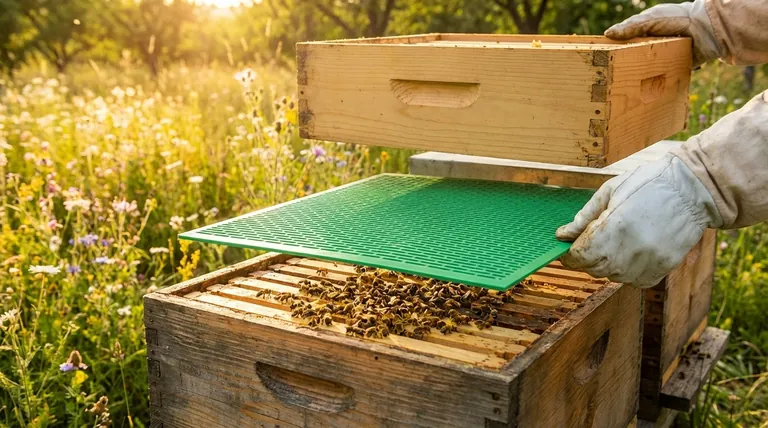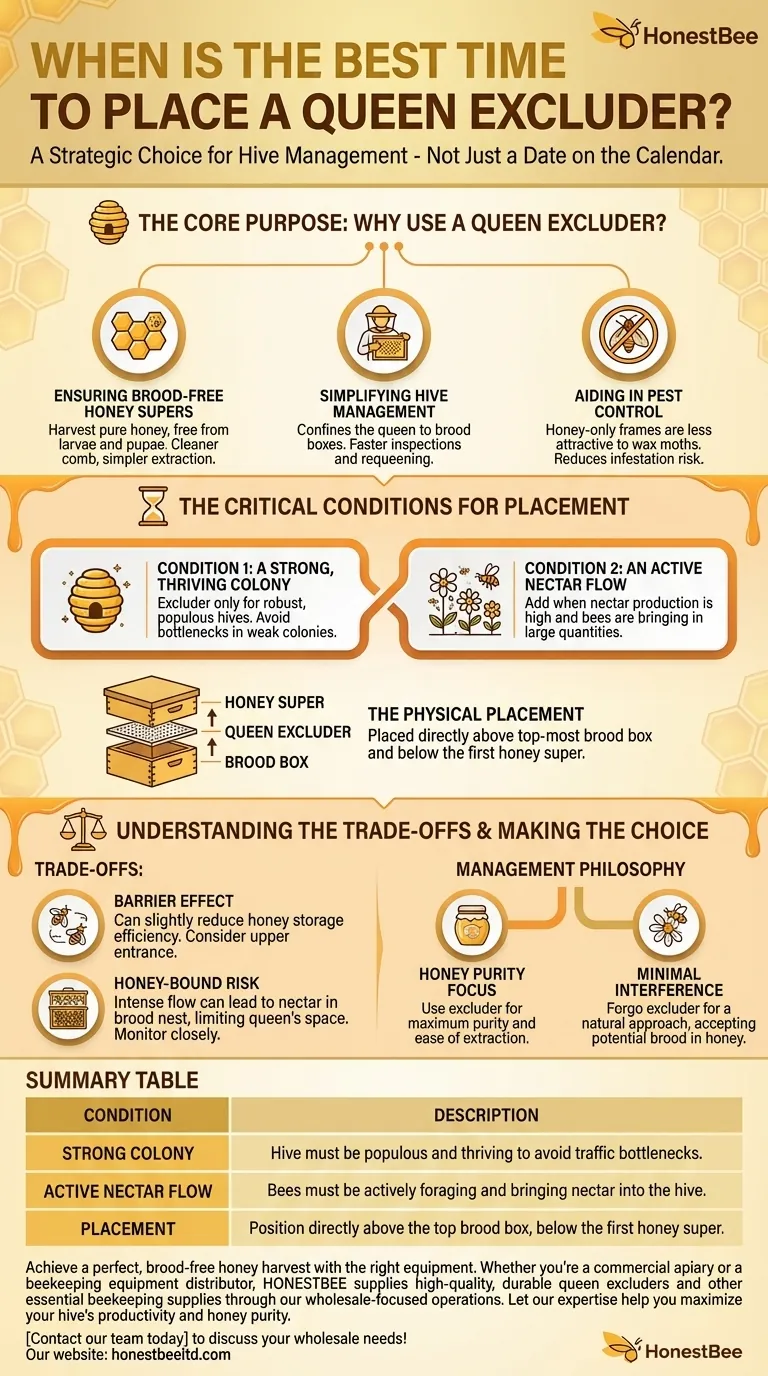The best time to place a queen excluder is when two specific conditions are met: your colony is strong and there is an active nectar flow. This typically coincides with the moment you decide to add your first honey super for the season, transforming the hive from a growing colony into a honey production unit.
The decision to use a queen excluder is not about a date on the calendar, but about a strategic choice in hive management. Its purpose is to create a clean separation between the queen's brood-rearing area and the beekeeper's honey collection supers, a goal that comes with distinct benefits and trade-offs.

The Core Purpose: Why Use a Queen Excluder?
A queen excluder is a simple tool with a clear objective: to control the queen's movement within the hive. It is a perforated sheet with openings large enough for worker bees to pass through, but too small for the larger queen.
Ensuring Brood-Free Honey Supers
The primary function of an excluder is to keep the queen from laying eggs in the honey supers.
This ensures the frames you harvest contain only pure honey, free from developing larvae, pupae, and their shed skins. This results in cleaner honeycomb and simplifies the extraction process significantly.
Simplifying Hive Management
By confining the queen to the brood boxes, you always know where to look for her.
This makes inspections, requeening, or assessing the queen's laying pattern much faster and less disruptive to the entire colony.
Aiding in Pest Control
Frames containing only honey are far less attractive to pests like wax moths.
Because wax moths primarily seek out protein-rich brood comb for their larvae, keeping the honey supers brood-free helps minimize the risk of infestation.
The Critical Conditions for Placement
Timing is less about the date and more about the state of the hive and the environment. Placing an excluder at the wrong time can hinder the colony's progress.
Condition 1: A Strong, Thriving Colony
An excluder should only be placed on a robust and populous hive.
Worker bees must travel through the excluder to deposit nectar in the supers. In a weak colony, this barrier can create a bottleneck, slowing traffic and potentially hindering the buildup of honey stores.
Condition 2: An Active Nectar Flow
The excluder should be added when plants are actively producing nectar and the bees are bringing it into the hive in large quantities.
Adding it when there is no nectar flow serves no purpose and only creates an unnecessary obstacle for the bees moving within the hive.
The Physical Placement: Between Brood and Honey
The correct placement is critical for the tool to function as intended.
A queen excluder is always placed directly above the top-most brood box and immediately below the first honey super you add.
Understanding the Trade-offs
Using a queen excluder is a management choice, and it's not without its debated downsides. Understanding these helps you make a fully informed decision.
The "Barrier" Effect on Hive Traffic
The excluder, by its nature, is a barrier. Some beekeepers believe it can slow down worker bees, slightly reducing the efficiency of honey storage.
Providing an upper entrance above the excluder can mitigate this by giving foragers a direct path to the honey supers.
The Risk of a "Honey-Bound" Brood Nest
If the queen is a prolific layer and the honey flow is intense, the workers may begin to store nectar in the brood chamber because it's easier than passing through the excluder.
This can limit the queen's laying space, a condition known as being honey-bound, which can reduce colony population and potentially trigger swarming. This requires vigilant management from the beekeeper.
Your Management Philosophy
Ultimately, the decision reflects your goals. Some beekeepers prefer a more hands-off, "natural" approach and are willing to work around brood in honey frames.
Others prioritize efficiency and predictability in their honey harvest. Neither approach is wrong; they simply serve different objectives. Observing your bees' natural tendencies—such as whether they maintain a compact brood nest on their own—can guide your decision.
Making the Right Choice for Your Goal
Base your decision on what you want to achieve with your hive.
- If your primary focus is maximum honey purity and ease of extraction: Use a queen excluder as soon as you add the first honey super to a strong colony during a nectar flow.
- If your primary focus is minimal interference and a more natural hive: Consider forgoing the excluder, but be prepared for the possibility of brood in your honey frames and adjust your harvesting process accordingly.
- If your primary focus is queen rearing or colony control: Use the excluder as a reliable tool to isolate the queen in a specific area of the hive for easy access and management.
An informed beekeeper makes decisions based on observation and clear goals, not just tradition.
Summary Table:
| Condition | Description |
|---|---|
| Strong Colony | Hive must be populous and thriving to avoid traffic bottlenecks. |
| Active Nectar Flow | Bees must be actively foraging and bringing nectar into the hive. |
| Placement | Position directly above the top brood box, below the first honey super. |
Achieve a perfect, brood-free honey harvest with the right equipment. Whether you're a commercial apiary or a beekeeping equipment distributor, HONESTBEE supplies high-quality, durable queen excluders and other essential beekeeping supplies through our wholesale-focused operations. Let our expertise help you maximize your hive's productivity and honey purity. Contact our team today to discuss your wholesale needs!
Visual Guide

Related Products
- High Performance Plastic Queen Excluder for Beekeeping and Apiary Management
- Professional Plastic Queen Excluder for Modern Beekeeping
- Premium Wood Framed Metal Wire Queen Bee Excluder
- Wooden Queen Bee Excluder for Beekeeping
- Plastic Queen Bee Excluder for Bee Hive Wholesale
People Also Ask
- What happens if I don't use a queen excluder? Understand the impact on your honey harvest.
- When is the typical time frame for harvesting honey and removing the queen excluder? Optimize Your Hive Management
- What are the benefits of a queen excluder? Ensure Pure Honey & Simplify Hive Management
- How does a queen excluder affect honey storage? Maximize Clean Honey Yields in Your Hive
- What impact does a queen excluder have on colony defensiveness? Control Hive Temperament for Safer Beekeeping



















